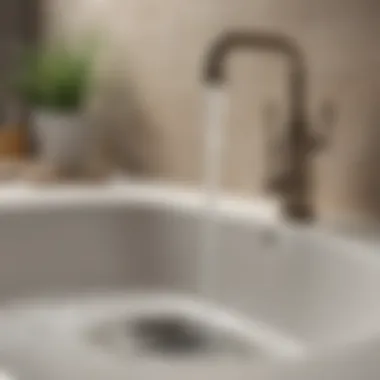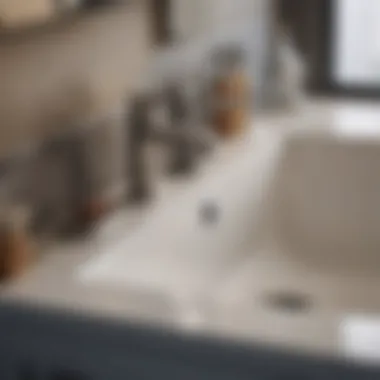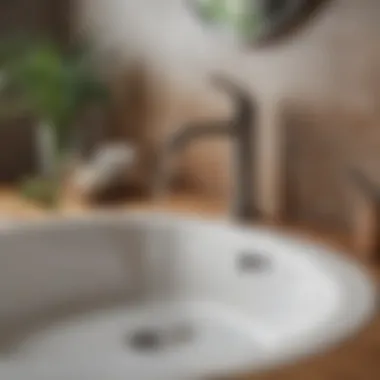Expert Guide: How to Unclog a Slow Draining Bathroom Sink with Ease


Are you facing the nuisance of a slow draining bathroom sink? It's a common household issue that can disrupt your daily routine. In this comprehensive guide, we will delve into the step-by-step process of unclogging your bathroom sink efficiently. From identifying the underlying causes of the clog to implementing DIY solutions, we've got you covered!
Identifying the Root Cause
Before diving into the unclogging process, it's crucial to identify what's causing the slow drain. This could range from hair buildup to soap scum or even mineral deposits. By understanding the root cause, you can choose the most appropriate method for unclogging the sink.
Tools and Materials Needed
Gather all the necessary tools and materials before starting the unclogging process. You may need a plunger, a pipe wrench, baking soda, vinegar, and a drain snake. These items will aid you in effectively clearing the clog and restoring proper drainage to your sink.
Step-by-Step Unclogging Process
- Remove Obstructions: Start by removing any visible obstructions such as hair or debris from the sink drain using gloves.
- Plunge the Drain: Use a plunger to create a seal around the drain opening and plunge vigorously to dislodge the clog.
- Try Baking Soda and Vinegar: Pour a mixture of baking soda and vinegar down the drain to break down stubborn clogs and eliminate odors.
- Utilize a Drain Snake: If the clog persists, use a drain snake to reach deeper into the pipes and remove the obstruction.
- Flush with Hot Water: Finish the process by flushing the drain with hot water to clear any remaining debris and ensure smooth drainage.
Maintenance Tips
Prevent future clogs by implementing simple maintenance practices. Regularly flush the drain with hot water, use a hair catcher to trap debris, and avoid pouring grease or large food particles down the sink. These habits will help keep your bathroom sink running smoothly.
Final Thoughts
Stay informed, and ensure a hassle-free sink experience in your daily routine!
Introduction
In this detailed guide on unclogging a slow draining bathroom sink, we will delve into every aspect of this common household nuisance. From identifying the initial signs of a slow draining sink to exploring natural and mechanical DIY solutions, this article aims to equip you with the knowledge and tools necessary to restore optimal functionality to your bathroom sink.
Understanding the Issue
Signs of a Slow Draining Sink
Signs of a slow draining sink can manifest in various ways, such as water pooling in the basin or a noticeable decrease in drainage speed. This signals a potential underlying clog that requires attention. Recognizing these signs early on is crucial in addressing the issue effectively and preventing further damage to your plumbing system. While inconvenient, a slow draining sink serves as a timely warning to tackle the problem before it escalates.
Common Causes of Bathroom Sink Clogs


To understand how to unclog a bathroom sink, knowing the common causes of clogs is paramount. Factors like hair accumulation, soap scum build-up, and foreign objects slipping into the drain can impede water flow. By identifying these culprits, you can tailor your unclogging method to suit the specific issue at hand. Recognizing the root cause ensures a targeted approach towards achieving a free-flowing drainage system.
Importance of Timely Unclogging
Preventing Further Damage
Timely unclogging is essential to prevent further damage to your sink and plumbing lines. Ignoring a slow draining sink can lead to more severe blockages, corrosion, or even pipe leaks. By taking proactive measures at the first sign of trouble, you safeguard your plumbing system from extensive repairs or replacements in the future.
Maintaining Hygiene
Apart from structural concerns, a clogged sink poses cleanliness issues. Stagnant water in the basin becomes a breeding ground for bacteria and molds, compromising the hygiene of your bathroom. By addressing clogs promptly, you not only ensure smooth drainage but also uphold a sanitary environment for your household members. Prioritizing hygiene is a cornerstone of effective sink maintenance procedures.
Identifying the Problem
When encountering a slow draining bathroom sink, the initial step is to accurately identify and comprehend the underlying problem to implement effective solutions. Understanding the issue at hand is crucial, as it sets the foundation for successful unclogging processes. This section delves into the significance of pinpointing the problem accurately in unclogging initiatives.
Initial Assessment
Checking Water Flow
Checking the water flow remains a pivotal aspect in the preliminary assessment of a slow draining bathroom sink. By assessing the water flow, one can discern the rate at which water passes through the drain, shedding light on potential constrictions within the plumbing system. The methodical examination of water flow aids in determining the severity of the blockage and guides further corrective measures. This meticulous inspection provides valuable insights into the functionality of the sink, facilitating informed decision-making processes.
Observing Water Levels
Observing water levels is another essential component of the initial assessment process when addressing a sluggish draining sink. By monitoring the water levels in the sink, one can infer the level of blockage hindering the drainage system’s efficiency. Discrepancies in water levels can indicate the presence of obstructions within the pipes or drain, signifying the need for unclogging interventions. This observation strategy aids in gauging the extent of the clog and aids in formulating tailored solutions for efficient drainage in the bathroom sink.
Locating the Blockage
Below the Sink
Exploring the area below the sink is a key strategy in identifying and rectifying sink blockages effectively. By investigating beneath the sink, one can visually inspect the piping system, searching for any visible signs of blockage such as accumulated debris or sediment. This method allows for a hands-on approach to locating and addressing blockages, offering a clearer understanding of the clog’s nature and facilitating targeted remedial actions. While the approach might require physical exertion, it provides a practical and direct method of pinpointing sink obstructions.
Within the Drain


Examining the interior of the drain is an essential step in the blockage identification process, enabling a thorough assessment of potential clogging sources. By investigating within the drain, individuals can detect blockages obscured from external view, such as hair accumulation or organic matter deposits. This detailed exploration of the drain interior offers insights into the specific location and composition of the obstructions, aiding in the selection of tailored strategies for dislodging the clog. Though this method may necessitate specialized tools for probing, it presents a comprehensive approach to blockage identification and resolution.
DIY Solutions
DIY solutions play a crucial role in unclogging a slow draining bathroom sink as they offer practical and cost-effective methods for tackling common clogging issues. By performing DIY solutions, homeowners can address minor clogs promptly, preventing them from escalating into more severe problems that may require professional intervention. Not only do these solutions save time and money, but they also empower individuals to take proactive measures in maintaining their sink's functionality. When dealing with a slow draining sink, embracing natural and mechanical remedies can significantly improve the situation without the need for external assistance.
Natural Remedies
Natural remedies such as Baking Soda and Vinegar present effective alternatives to chemical-based cleaners, minimizing the use of harsh substances while achieving comparable results. Baking Soda, known for its abrasive properties, combines with Vinegar's acidic nature to create a powerful foaming reaction that helps break down organic matter causing clogs. This eco-friendly solution is not only safe for the environment but also gentle on plumbing fixtures, making it a preferred choice for eco-conscious individuals looking to unclog their bathroom sinks effectively.
- Baking Soda and Vinegar The combination of Baking Soda and Vinegar creates a fizzing action that helps dislodge debris and residue within the sink's drain, promoting smoother water flow. This natural remedy is non-toxic, making it safe for households with children and pets. While the efficacy of this method may vary depending on the severity of the clog, it serves as a preventive measure against future blockages, enhancing the overall performance of the sink system.
- Hot Water Flush Utilizing a Hot Water Flush involves pouring boiling water down the drain to dissolve accumulated grease and organic matter. This simple yet effective method helps remove minor obstructions and improves water drainage within the sink. However, caution must be exercised when using hot water to avoid damaging PVC pipes or causing injury. Despite its limitations in addressing stubborn clogs, the Hot Water Flush remains a recommended initial step in unclogging a slow draining bathroom sink.
Mechanical Methods
Mechanical methods like Plunging the Drain and Using a Drain Snake offer a more hands-on approach to resolving persistent clogs that natural remedies may not adequately address. These techniques provide targeted solutions by physically dislodging blockages or retrieving debris obstructing the drain, restoring optimal water flow and sink functionality.
- Plunging the Drain Plunging the drain involves creating pressure through up-and-down movements with a plunger to dislodge clogs obstructing the pipe. This method is effective in clearing minor blockages caused by the accumulation of hair, soap scum, or other debris. While simple and cost-efficient, proper technique and equipment selection are crucial for achieving successful results with this mechanical approach.
- Using a Drain Snake A Drain Snake, also known as a plumber's snake or auger, offers a more targeted solution for removing stubborn clogs deep within the pipe system. By inserting the tool into the drain and rotating it to catch or break apart obstructions, users can address blockages that resist conventional plunging methods. While this method requires some skill and caution to prevent damage to the fixtures or pipes, it proves effective in resolving complex blockages that natural remedies may not adequately tackle.
Professional Assistance
When dealing with a persistent or complex bathroom sink clog, the expertise of a professional plumber becomes indispensable. Professional assistance plays a vital role in this article as it offers specialized knowledge, tools, and techniques to address stubborn blockages effectively. By enlisting the services of a qualified plumber, individuals can save time and ensure a thorough resolution of the drainage issue. The inclusion of this section underscores the recognition that some clogs may require professional intervention for a swift and lasting solution.
When to Call a Plumber
Persistent Clogs
Persistent clogs, characterized by recurring or enduring blockages in bathroom sinks, demand professional attention due to their resistant nature. These clogs are often indicative of underlying issues within the plumbing system that necessitate expert evaluation and remediation. By delving into the causes of persistent clogs, plumbers can implement targeted solutions to prevent future recurrence, ensuring sustained sink functionality. While persistent clogs pose challenges, they serve as crucial indicators prompting the timely involvement of a skilled plumber for comprehensive problem-solving.
Complex Blockages
Complex blockages signify more intricate obstructions within the bathroom sink drain, warranting specialized handling by professional plumbers. These blockages may involve multiple factors contributing to the slow drainage, such as deep-seated debris or structural concerns. Dealing with complex blockages requires advanced tools and techniques that only experienced plumbers possess. Despite the complexity, addressing these blockages effectively enhances the overall performance of the sink system. By exploring the nuances of complex blockages, readers gain insight into the critical role played by professional plumbers in resolving challenging drainage issues.
Choosing the Right Plumbing Service


Read Reviews
Reading reviews of plumbing services before engaging them ensures informed decision-making and optimal service selection. Reviews provide firsthand accounts from previous customers regarding the quality, reliability, and professionalism of plumbing providers. By considering the feedback shared in reviews, individuals can gauge the reputation and track record of different plumbing services. This informed approach aids in selecting a trusted plumbing expert suited to address specific clogging issues efficiently.
Get Multiple Quotes
Obtaining multiple quotes from various plumbing services enables individuals to compare pricing, services offered, and customer reviews comprehensively. By collecting and evaluating multiple quotes, individuals can make a cost-effective and informed choice based on their budget and the scope of services required. This comparative analysis streamlines the selection process, empowering individuals to choose a plumbing service that aligns with their needs and expectations effectively.
Preventive Measures
Preventive measures play a crucial role in maintaining an optimal bathroom sink functionality. By implementing proactive steps, homeowners can prevent potential clogs and ensure smooth drainage over time. The significance of preventive measures in this context cannot be overstated. Regular maintenance helps in identifying and addressing issues before they escalate into serious problems. By adhering to preventive measures, individuals can avoid costly repairs and inconveniences associated with a slow-draining sink. Being proactive also promotes a clean and hygienic environment within the bathroom, enhancing overall sanitation standards.
Maintenance Tips
Regular Cleaning
Regular cleaning serves as a cornerstone in the realm of preventive maintenance for bathroom sinks. Removing debris, soap scum, and other buildups on a consistent basis prevents blockages and restrictions in water flow. This simple yet effective task ensures that the drain remains clear and functional, minimizing the risk of clogs. The affordability and accessibility of cleaning products make this a popular choice for homeowners looking to maintain their sink's optimal performance. While regular cleaning demands minimal effort, the long-term advantages it offers in preventing plumbing issues make it a worthwhile endeavor.
Hair Catchers
Hair catchers are essential accessories that contribute significantly to the prevention of clogs in bathroom sinks. These small devices trap hair and other debris, preventing them from entering and obstructing the drain. Their simple design and ease of installation make them a practical and popular choice for individuals seeking efficient solutions for clog prevention. The unique feature of hair catchers lies in their ability to capture hair before it accumulates within the drain, thereby reducing the likelihood of blockages. While their advantages are evident in maintaining clear drains, users should ensure regular cleaning of the catcher to retain its effectiveness.
Awareness of What Goes Down the Drain
Avoiding Grease Buildup
Preventing grease buildup is essential in preserving the functionality of bathroom sinks and drains. Grease residue can solidify over time, leading to blockages and impeding water flow. By avoiding the disposal of grease down the sink, individuals can protect their plumbing system from obstructions and maintain efficient drainage. The key characteristic of this practice is its contribution to preventing long-term damage and ensuring the smooth operation of the sink. While simple in concept, the impact of avoiding grease buildup on drain health is substantial, making it a valuable choice for homeowners.
Proper Disposal of Debris
Proper disposal of debris is fundamental to keeping bathroom sinks free from clogs. By ensuring that only appropriate materials are disposed of in the drain, individuals can prevent blockages and maintain optimal sink performance. The unique feature of this practice lies in its proactive approach to reducing the risk of plumbing issues caused by debris accumulation. While the benefits of proper debris disposal may seem straightforward, their importance in promoting efficient drainage cannot be overstated. Adhering to this practice helps in prolonging the lifespan of the plumbing system and reducing the need for costly repairs.
Conclusion
In this exhaustive guide on resolving the issue of a slow draining bathroom sink, the Conclusion section plays a vital role in summarizing the essential aspects discussed throughout the article. As readers navigate the intricacies of unclogging their sinks, the Conclusion serves as the pinnacle of knowledge attainment, highlighting key takeaways and emphasizing the criticality of proper maintenance. By underlining the significance of regular upkeep and awarenesFlush method involves pouring boiling water into the drain to melt and dislodge accumulated grease or soap scum. This straightforward yet effective technique can offer a quick solution to minor clogs without the need for harsh chemicals or specialized tools. Its ease of application and minimal cost make it a favored choice for many seeking a DIY remedy for sluggish sink conditions.
Final Thoughts
The Final Thoughts section encapsulates a holistic viewpoint on sustaining smooth drainagesystem through regular maintenance and applying caution in disposing of waste. Understanding and implementing preventive measures can significantly reduce the occurrence of blockages and elongate the lifespan of plumbing fixtures. By adopting a proactive approach to sink maintenance, individuals can mitigate the inconvenience and costs associated with severe clogs and repairs, ensuring a seamlessly functional bathroom environment for years to come.



